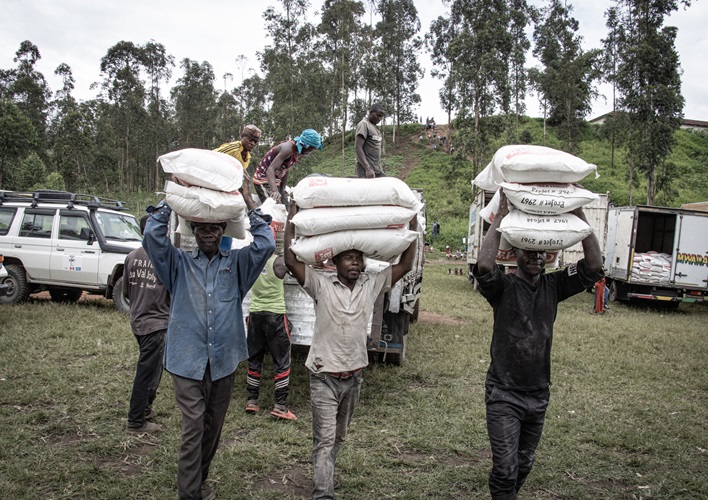When conditions are good, the Central Alberta growing project typically harvest number one grade wheat. This year, however, the project’s wheat was feed grade due to high moisture levels. (Photo: Submitted)
Over 4,000 acres dedicated to helping families overseas facing hunger
It was too hot. Too dry. Too wet. And too cold. Throw in some hail, and these were the conditions that farmers in Alberta had to contend with this season.
“We had to plant our red spring wheat about 10 days late,” says Terry Shenher, chair of the North East growing project in Bonnyville. “After that we had rain every 15 minutes through the year. Then, 58 per cent of our crops were damaged because of hail. When it finally came time to harvest, it was minus 16 with the wind chill and the crop was wet.”
Despite the conditions, farmers involved with the project ended up harvesting about 50 bushels per acre, with proceeds donated to Canadian Foodgrains Bank to help families experiencing hunger overseas.
A tough year for many
Weather varied regionally for the more than 30 growing projects in the province. For some, it was an average or above average yield. But a large number were affected by the poor weather, with several—including the North East project—needing to draw on crop insurance to help recover some of the losses.
There was no heat through the summer, and fall was very, very wet.
“It was a tough year,” says Terence Barg, Foodgrains Bank’s regional representative for northern Alberta. “There was no heat through the summer, and fall was very, very wet.”
So wet, in fact, that Leduc County declared a state of agricultural disaster in September due to the wet growing season. Lac Ste. Anne County had already declared an emergency in August. Then in late November, St. Paul County joined the chorus, saying that 35 per cent of crops in the area—mostly canola but other cereals, too—were still in the ground and covered in snow.
“We grew yellow peas this year, on land donated by a local farmer,” says Colin Boender of the Leduc and District growing project. “We seeded it early when it was dry, and it went in real nice. But in June it started raining and it just didn’t stop until the snow came.”
All that moisture led to weeds running rampant and presented a significant challenge operating machines on the land.
“So unfortunately, we probably got less than half off than we would in a usual year,” says Boender. “The crop yielded 25 bushels per acre, when the average for peas is over 50.”

Boender Grain Farms had to fend off more than a normal amount of weeds this year. The left side of this photo was seeded to wheat. The right side was not seeded at all. The same herbicide was applied on both sides. This shows that crop competition is a huge factor in weed control as the right has been completely taken over by weeds.
A bit further south, the Central Alberta growing project grew 70 acres of wheat that generated 70 bushels per acre—but they still faced challenges.
“It came off at 17 per cent moisture level, which is high, so it had to be dried at the elevator,” says Doug Maas, Central Alberta growing project committee member. “And we only got $5 a bushel, because it wasn’t number one or two grade—it was feed grade. If conditions are good, we typically get number one.”
Southern Alberta not without challenges
“In southern Alberta, the effects of extreme weather were somewhat less of a factor,” says Andre Visscher, Foodgrains Bank regional representative for the area. “Meltwater from the mountains helps with irrigation, plus the growing season is a bit longer.”
“We had great weather this year,” says Jeremy Wind, chair of the Taber growing project. “We planted spring wheat and got it in real early, and harvest went well. We have a great team here.”
Wind says they did get a big frost in the third week of September, and that was an issue for farmers in the region who were growing potatoes, sugar beets or corn. In the third week of August, hail damaged many crops, including all of the corn the region is famous for.
“But the growing project field wasn’t affected, and we’re happy about that,” says Wind. “Because the Foodgrains Bank is such a good cause. We constantly read about how efficient they are with donor dollars, and how many people are helped with the funds. And their focus is feeding people, so their efforts are critical because they help people in life-threatening situations.”
A lot of money was raised to help end global hunger.
Now that the snow is here for good, a few growing projects in Alberta will have to wait until spring to harvest.
“These farmers will need to both harvest and plant to start the season next year,” says Barg. “But all in all, thanks to farmers and farm supporters who didn’t give up on their projects in the face of all these challenges on their own farms, a lot of money was raised to help end global hunger. Thank you so much to everyone involved with growing projects, and everyone in the communities who support them.”
– Jason Permanand, Writer




